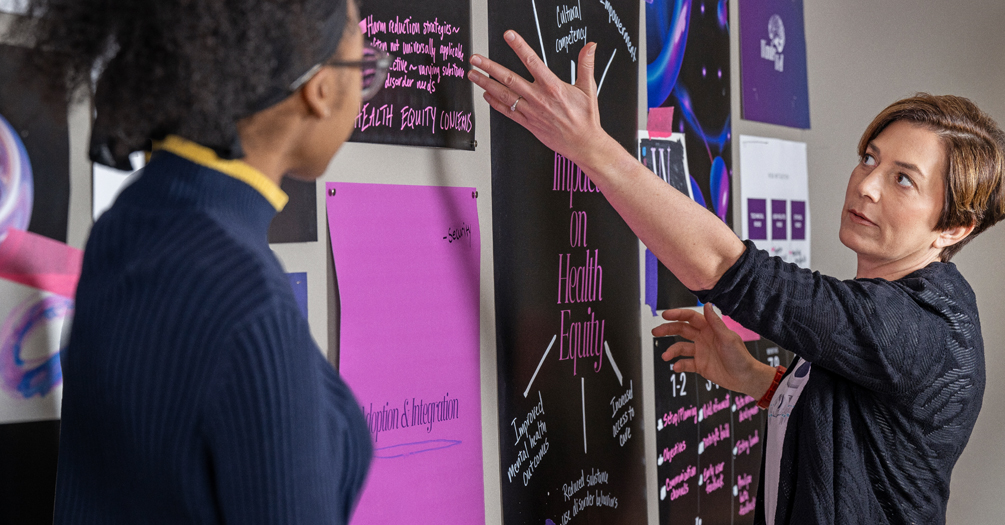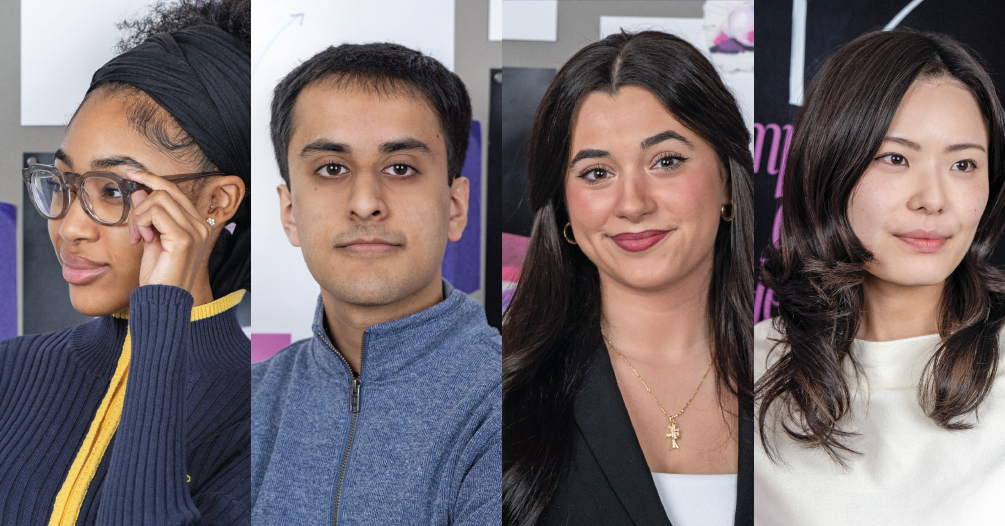Embracing AI in the classroom

A new frontier in public health education
By Bob Cunningham
Photos by Christina Merrill
More than 11 million young Americans between the ages of 13 and 25 suffered from a substance use disorder in 2023, according to the US National Survey on Drug Use and Health.
Young people dealing with the disorder often have an intense focus on using alcohol or drugs to the point where it takes over their lives. It’s a daunting issue that a student group at the University of Michigan School of Public Health is now focused on.
Enter WanderWell, an AI-powered tool offering 24/7, stigma-free support that leverages GPT-4 technology, a language model developed by OpenAI, to deliver empathetic, culturally competent care, harm reduction strategies, and access to local resources and emergency services. The app was created by a group of students in an artificial intelligence class taught by Frederique Laubepin at Michigan Public Health.
The team behind WanderWell consists of Michigan Public Health undergraduates Aarush Goel, Rino Fujimoto and Zhariyah Laughlin, as well as Isabella Lamacchia, a Master of Social Work student. The project focuses on health equity, providing personalized, judgment-free support for underrepresented groups.
“We wanted WanderWell to be rooted in science,” Lamacchia said. “Sources like the CDC and NIDA provide evidence-informed guidance through the app on substances, harm reduction and mental health resources. It also offers non-emergency support for parents, friends and others witnessing or experiencing substance use.”
WanderWell isn’t just an intriguing class project; the team is now focused on spending the next year rolling it out, developing, testing and collecting user feedback, while prioritizing data security and addressing challenges like cultural sensitivity and severe cases. The tool aims to enhance mental health outcomes, cut down substance use behaviors, and improve access to culturally competent care for at-risk adolescents.
INTERESTED IN A DEGREE from Michigan Public Health? Learn more about our programs.

Emerging technology
With applications ranging from personalized medicine to predictive analytics, AI’s potential to revolutionize public health is immense. Yet integrating AI into public health presents both opportunities and challenges.
Laubepin, an innovative educator at Michigan Public Health, was keenly aware of these dynamics when she redesigned her pioneering course, Public Health 555: Artificial Intelligence (AI) for Public Health.
“I knew I wanted to utilize AI in a way that harnessed its ability to solve actual problems, not just serve as an academic exercise,” said Laubepin, associate director for Instructional Services at Michigan Public Health. Among her many duties is designing new courses and redesigning existing ones, as well as integrating appropriate technology and learning tools into instruction.
In Fall 2024, she unveiled the latest iteration of the class, having carefully restructured it to align with the rapidly advancing capabilities of AI technology.
“In 2023, during the course’s initial offering, students couldn’t undertake a project of creating an AI app because the tools available for creating custom applications had not yet developed to their current state,” Laubepin said.
READ MORE about faculty, students, alumni and staff.
I knew I wanted to utilize AI in a way that harnessed its ability to solve actual problems, not just serve as an academic exercise.”
—Frederique Laubepin
More than 40 students enrolled in the class in Fall 2024; this included undergraduate and graduate students from Michigan Public Health, as well as a range of other majors from across the university. It was designed to engage students with hands-on experiences, culminating in a student showcase of AI-driven health equity projects. These weren’t mere theoretical exercises, but tangible solutions aimed at addressing real-world issues.
“This commitment to practical, impactful education led to the introduction of a health equity challenge, urging students to create projects that not only employ AI, but do so with a focus on improving community health outcomes,” Laubepin said.

AI for Health Equity Challenge
This year, Laubepin created the AI for Health Equity Challenge to engage students in developing AI solutions to tackle health disparities. The semester-long project’s goal was to enhance their understanding of AI’s role in public health, encouraging collaboration and practical application to create impact.
Participants gained research, technical and presentation skills while exploring potential community organizations partnerships.
Projects covered a broad spectrum of topics—ranging from water quality solutions in Michigan to mental health support systems in Kenya—demonstrating the versatility of AI applications in addressing public health concerns.
The success of these projects reflects the strategic course design. Students began with individual proposals before merging into teams, fostering collaboration and a diversity of ideas. They were tasked not only with creating apps, but also with producing detailed specification sheets—a novel approach aimed at enhancing transparency and understanding of AI technologies, which are often criticized for their opacity.
Collaboration was key to the process. Despite the varied interests—from cancer assistance to elder care—the students shared a common goal: using AI to foster health equity. The result was a case competition at the end of the semester won by WanderWell.
“It was remarkable how themes emerged from the individual proposals,” Laubepin said.
This convergence of ideas allowed for interdisciplinary teams to mirror real-world settings where diverse expertise is essential in solving complex problems.
SUPPORT research and engaged learning at Michigan Public Health.

Anticipating the future
Laubepin said the dynamic nature of AI means the course—and her teaching—must continuously adapt.
“There’s still a need for people to understand how AI works and how it arrives at the answers it gives you,” she said, pointing to the importance of understanding the underpinnings of AI beyond its applications.
Interestingly, students’ perceptions of AI were mixed yet pragmatic. They recognized AI’s necessity in future careers.
“Students realize this is something they need to learn about,” Laubepin said. “They aren’t necessarily early adopters or enthusiasts; they just know it’s essential.
“AI will be part of their professional lives. It is something that they know employers are going to want to see. It’s something that will make them competitive.”
Fujimoto, a senior working toward a Bachelor of Arts degree at Michigan Public Health, enjoyed working on the project, but still plans to tread lightly when it comes to AI in the future.
“My coursework has shaped my understanding of AI applications within and outside of public health and the ways I engage with emerging discourse surrounding it in real time,” she said. “Many of my peers are vocal about the threat AI poses, especially in relation to our environment, creative industries and social-criminal-legal systems in power. I believe we should lean into these concerns before we even begin to consider the potential AI offers in the field of public health.”
Working on the WanderWell app and seeing firsthand how AI can transform public health interventions has completely shifted my perspective.”
— Zhariyah Laughlin
Laughlin, also a senior in the BA program, didn’t have focused academic and career interests before the class. Now after completing Laubepin’s class, she has been inspired and motivated to pursue graduate programs that combine AI, big data and public health.
“Working on the WanderWell app and seeing firsthand how AI can transform public health interventions has completely shifted my perspective,” she said. “I realize AI isn’t just a tool. It’s a game changer in how we approach healthcare disparities, patient outcomes and data-driven policies. The ability to use AI to uncover hidden patterns in health data, optimize resource allocation, and personalize intervention have solidified my passion of pursuing a career in public health data science.
“Now as I move forward in my academic and professional journey, AI isn’t just a consideration. It’s an essential part of the work I want to do. Looking ahead, I am eager to dive deeper into AI-driven public health solutions, and I can’t wait to continue learning, researching and innovating in this space.”
Read More in This Issue of Findings
